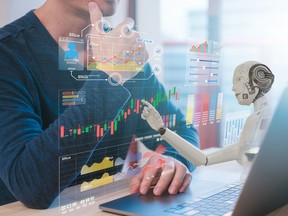Products aimed to increase productivity by tracking employee activity are often met with resistance

“AI is a fairly decent assistant and it’s getting into the realm of decision support,” Te Wu, an associate professor at the Feliciano School of Business at Montclair State University in New Jersey, said. “It cannot just generate ideas or vast searches, but it can make certain recommendations as well.”
He said AI can help people make more informed decisions, act as an analyst or consultant and help with portfolio recommendations, but it shouldn’t take the place of a project manager and make decisions about employee performance.
AI can collect data and information, allow for the automation of tasks and faster analysis while also providing feedback and helping with creative brainstorming, but people should still be responsible for the actions that follow.
“You still need that human factor in finalizing those decisions; you have to have that human touch,” Wu said. “AI is a great enabler and an excellent assistant. It will give you a lot of ideas that you probably don’t have otherwise, but you still have to own that work and the next steps. Owning that requires a high degree of diligence.”
You have to have that human toucH
Te Wu
Valerio De Stefano, a professor and Canada Research Chair in Innovation Law and Society at York University in Toronto, said there needs to be a strict boundary between what AI is allowed to do when it comes to decision-making in the office.
“There’s a sort of misunderstanding about what technology should be about,” he said. “Tech could help us be more productive, help us manage our tasks more efficiently. What it cannot do is to replace the judgment of the human supervisor and assess whether what we are doing is productive or not.”
Software such as Copilot and Motion can help individuals manage their time and tasks, and are generally considered useful tools for staying organized. Other products, such as ActivTrak and Hubstaff, aim to increase productivity by tracking employee activity, but are often met with resistance.
But participants who were told that AI was there to support their development rather than to watch and judge responded more positively.
“People don’t want to be treated as cogs, so of course there is resistance,” De Stefano said. “It speaks to a big distrust of your workforce if you think a computer can track if they are active or not.”
He said such programs can hurt employee morale and productivity, and they may not even be good at assessing a person’s job.
“In most cases, people know things about the job that no one else does. Our jobs are extremely complicated,” he said. “It doesn’t help you do your job more efficiently if you have to worry and watch your back. People get resistant and defensive; they develop stress that is unnecessary.”
Since AI software is created by programmers, both De Stefano and Wu point out that it’s difficult for AI alone to understand a specific job and make an accurate productivity assessment for that role.
“Machines cannot be programmed to take into account all the complex things that go into our work,” De Stefano said.
Wu offered his own work habits and history as an example. He said he operates methodically, taking up all the time given to him to work on a particular product, and wonders if an algorithm could accurately assess his workflow despite his record of success. He said his managerial style, which is walking around the office and connecting with employees in person, may be perceived by a program as idle or inactive time.
Even talking on the phone to a journalist about artificial intelligence might be seen by an algorithm as unproductive work.
“More information isn’t always necessarily better,” Wu said. “How we truly measure value-added work and productivity needs to be defined in a more refined way. I’m not sure it can even be measured with a knowledge worker.”
De Stefano said it is imperative that workers feel supported by AI and have a level of involvement in how it is used, particularly in jobs that require critical thinking, creative problem-solving and decision-making.
“In order to have a system that helps you, you should ask for bottom-up input from your employees. Especially if you are a more sizable company, ask people what you can do to help them,” he said. “No one understands the job better than the people who do it, especially white-collar knowledge work.”
Some companies may believe they can do away with middle management and perceived bureaucracies by implementing AI, but connecting with employees and assessing work is best done by humans, the experts say.
Wu said our innate ability to pause when presented with key information or roadblocks instead of just following a programmed set of rules is key.
“The problem with AI, as far as I know, is we have not commanded the system to think creatively, to think in greater context,” he said. “What makes us human is our additional degree of intelligence and diligence when there is something that requires revisiting and more thought. I don’t know if there is such a pause button in AI.”